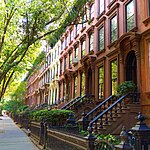115-119 Eighth Avenue (Brooklyn)

115–119 Eighth Avenue, also known as the Adams House, is a historic house at Eighth Avenue and Carroll Street in Park Slope, Brooklyn, New York City. It was built in 1888 as a double house, and was commissioned by Thomas Adams Jr., who invented the Adams Chiclets automatic vending machine. It was designed by noted architect C. P. H. Gilbert in the Richardsonian Romanesque style, and is considered to be one of the best examples of that style extant in New York City, "worthy of H. H. Richardson." The house is built of sandstone, terra cotta and brick on a brownstone base, and was the first house in the neighborhood with an elevator. It has now been converted into apartments. The building is located within the Park Slope Historic District, which was designated by the New York City Landmarks Preservation Commission in 1973.
Excerpt from the Wikipedia article 115-119 Eighth Avenue (Brooklyn) (License: CC BY-SA 3.0, Authors, Images).115-119 Eighth Avenue (Brooklyn)
8th Avenue, New York Brooklyn
Geographical coordinates (GPS) Address Nearby Places Show on map
Geographical coordinates (GPS)
| Latitude | Longitude |
|---|---|
| N 40.672271 ° | E -73.973424 ° |
Address
8th Avenue 115
11215 New York, Brooklyn
New York, United States
Open on Google Maps










